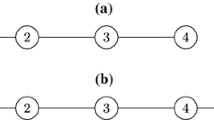Abstract
Power of nodes has been studied in many works, in particular, using centrality concepts. However, in some applications, a large flow between two nodes implies that these nodes become too interdependent on each other. For instance, in trade networks, the possible shortage of flow between two countries may lead to the deficit of goods in the importing country but, on the other hand, it may also affect the financial stability of the exporting country. This feature is not captured by existing centrality measures. Thus, we propose an approach that takes into account interdependence of nodes. First, we evaluate how nodes influence and depend on each other via the same flow based on their individual attributes and a possibility of their group influence. Second, we present several models that transform information about direct influence to a single vector with respect to the network structure. Finally, we compare our models with centrality measures on artificial and real networks.
Access this chapter
Tax calculation will be finalised at checkout
Purchases are for personal use only
Similar content being viewed by others
References
Mancheri, N.: China and its neighbors: trade leverage, interdependence and conflict. Contemp. East Asia Stud. 4(1), 75–94 (2015). https://doi.org/10.1080/24761028.2015.11869082
Kojima, K.: The pattern of international trade among many countries. Hitotsubashi J. Econ. 5(1), 19–36 (1964)
Drysdale, P., Garnaut, R.: Trade intensities and the analysis of bilateral trade flows in a many-country world: a survey. Hitotsubashi J. Econ. 22(2), 62–84 (1982)
Frankel, J., Rose, A.: The endogeneity of the optimum currency area criteria. Econ. J. 108(449), 1009–1025 (1998)
Freeman, L.: Centrality in social networks: conceptual clarification. Soc. Netw. 1, 215–2391 (1979)
Bonacich, P., Lloyd, P.: Eigenvector-like measures of centrality for asymmetric relations. Soc. Netw. 23, 191–201 (2001)
Kleinberg, J.: Authoritative sources in a hyperlinked environment. J. ACM 46, 604–632 (1999)
Wei, W., Liu, G.: Bringing order to the world trade network. In: IPEDR Proceedings. IACSIT Press, Singapore, vol. 28, p. 88 (2012)
Aleskerov, F., Meshcheryakova, N., Shvydun, S.: Centrality measures in networks based on nodes attributes, long-range interactions and group influence. arXiv preprint arXiv:1610.05892 (2016)
Aleskerov, F., Meshcheryakova, N., Shvydun, S.: Power in network structures. In: Models, Algorithms, and Technologies for Network Analysis. Springer Proceedings in Mathematics and Statistics, vol. 197, pp. 79–85. Springer, Heidelberg (2017)
Martin, P., Mayer, T., Thoenig, M.: Make trade not war? CEPREMAP Working Papers (Docweb) 0515, CEPREMAP (2005)
Tanious, M.: The impact of economic interdependence on the probability of conflict between states. Rev. Econ. Polit. Sci. 4(1), 38–53 (2019). https://doi.org/10.1108/REPS-10-2018-010
Aleskerov, F., Meshcheryakova, N., Nikitina, A., Shvydun, S.: Key borrowers detection by long-range interactions. arXiv preprint arXiv:1807.10115 (2016)
OECD Bilateral Trade in Goods by Industry and End-use (BTDIxE), ISIC Rev.4. https://stats.oecd.org/Index.aspx?DataSetCode=BTDIXE. Accessed 1 Dec 2019
Acknowledgments
The article was prepared within the framework of the Basic Research Program at the National Research University Higher School of Economics (HSE) and supported within the framework of a subsidy by the Russian Academic Excellence Project ‘5–100’. This work is also supported by the Russian Foundation for Basic Research under grant No. 18-01-00804a Power of countries in the food security problem.
Author information
Authors and Affiliations
Corresponding author
Editor information
Editors and Affiliations
Rights and permissions
Copyright information
© 2020 The Editor(s) (if applicable) and The Author(s), under exclusive license to Springer Nature Switzerland AG
About this paper
Cite this paper
Shvydun, S. (2020). Power of Nodes Based on Their Interdependence. In: Barbosa, H., Gomez-Gardenes, J., Gonçalves, B., Mangioni, G., Menezes, R., Oliveira, M. (eds) Complex Networks XI. Springer Proceedings in Complexity. Springer, Cham. https://doi.org/10.1007/978-3-030-40943-2_7
Download citation
DOI: https://doi.org/10.1007/978-3-030-40943-2_7
Published:
Publisher Name: Springer, Cham
Print ISBN: 978-3-030-40942-5
Online ISBN: 978-3-030-40943-2
eBook Packages: Physics and AstronomyPhysics and Astronomy (R0)




